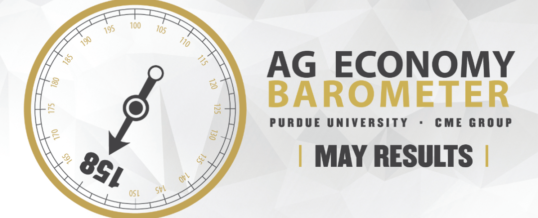
WEST LAFAYETTE, INDIANA, US — The outlook of US farmers on the nation’s agriculture economy dimmed considerably in May, with the Purdue University/CM Group Ag Economy Barometer falling 20 points to 158, the lowest mark for the monthly survey since September 2020.
Producers were less optimistic about both current conditions and the future of the agricultural economy. The Index of Current Conditions dropped 17 points to a reading of 178 and the Index of Future Expectations fell 20 points to a reading of 149. The Ag Economy Barometer is calculated each month from 400 US agricultural producers’ responses to a telephone survey. This month’s survey was conducted from May 10-14.
“The potential for changing tax rules and rising input costs appeared to be on producers minds this month and were the primary drivers for the Ag Barometer’s decline,” said James Mintert, the barometer’s principal investigator and director of Purdue University’s Center for Commercial Agriculture.
The Farm Financial Performance Index declined to 126 from a record high 138 in April. Although May’s index was 12 points lower than a month earlier, it was still the second highest reading since the financial performance question was first posed in spring 2018 suggesting strong crop prices continue to support farm incomes.
This month’s survey included a new question focused on producers’ plans to construct new buildings or grain bins. Fifty-nine percent of respondents said their construction plans for the upcoming year are lower compared to a year ago and just 28% said their construction plans were about the same as a year ago.
“Rising construction costs are likely a contributing factor to weaker construction plans,” Minert said.
Producers remain very concerned about possible changes to US tax policy. In a series of questions first posed last month, 78% of survey respondents said they are very concerned that the changes in tax policy being proposed by the Biden administration will make passing their farm on to the next generation more difficult. Additionally, 83% of producers expect capital gains tax rates to rise over the next five years; 71% are very concerned about a possible loss of the step-up in cost basis for inherited estates; and 66% say they are very concerned about a possible reduction in the estate tax exemption for inherited estates.
After declining last month, the Long-Run Farmland Value Expectations Index rose 10 points to a record high reading of 158, with two-thirds of producers in the survey saying they expect farmland values to rise over the next five years. The Short-Run Farmland Value Expectation Index remained near its all-time high, falling just 2 points below the record high set in April of this year.
Producers’ expectations for good versus bad times in US agriculture have undergone a marked shift. For example, in May just 27% of respondents said they expect good times in US agriculture during the next five years, the lowest reading in the survey’s history and down 12 points from a month earlier. One driver of this shift appears to be the discrepancy between expectations for the crops versus livestock sectors in the upcoming five years. This month over half (54%) of respondents said they expect widespread good times for the crops sector in the next five years whereas just one-fourth (26%) of producers said they expect widespread good times for the livestock sector.
“The difference in expectations for these two principal sectors of the agricultural economy could help explain why producers appear to be very bullish about farmland values and cash rental rates while at the same time expressing less optimism about both current conditions and future expectations for the agricultural economy overall,” Mintert said.
Read the full Ag Economy Barometer report at https://purdue.ag/agbarometer.
Source: World Grain
JUN
2021


About the Author: